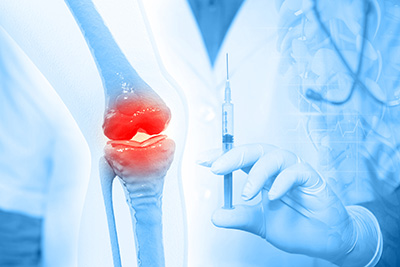
Orthopedic medicine has always been at the forefront of evolving medical developments. It was a sports medicine triumph involving a famous football player who was injured before a Super Bowl game – using platelet-rich plasma (PRP) – that catapulted PRP front and center into the consciousness of most American medical consumers. PRP is now considered one of the hallmark therapies to emerge in the field of Regenerative Medicine.
Regenerative Medicine includes therapies like PRP, prolotherapy, stem cell therapies, and viscosupplementation, all of which are used to treat a variety of diseases or injuries that are otherwise difficult or impossible to treat.
The simple answer is that Regenerative medicine is a form of treatment that uses the body's own cells to promote healing.
Some examples of Regenerative Medicine include:
Another innovative example is 3D bioprinting, which is an emerging technology that uses 3D printing to repair injuries to the face, extremities, even the genitourinary region, as well as skin anywhere on the human body. Another exciting area of research involves Induced pluripotent stem cells, which is a unique treatment utilizing stem cells that have unlimited self-renewal abilities.
The idea began in the 18th century when naturalists studied the regenerative abilities of organisms like earthworms that could regrow body parts. This concept of tissue regeneration opened the door to modern research into tissue engineering and the modern field of Regenerative Medicine. Tissue engineering, which is focused on creating functional substitutions for damaged tissue, together with stem cell research and the goal of tissue repair or regeneration, led to modern applications like PRP.
When it comes to understand the complex science behind Regenerative Medicine, “How does it work?” is the most common question we get. The answer is: each procedure works a little differently. How Prolotherapy works is quite different from PRP or 3D Bioprinting.
Another issue in regard to the science of Regenerative Medicine is the misunderstanding that Regenerative Medicine has reached the point where we can actually regenerate tissue that no longer exists. It can’t – not yet. But that doesn’t mean you can’t benefit from a treatment like PRP, it can help with pain reduction, overall tissue support and improving integrity of the surrounding environment
Regenerative Medicine has shown promise for certain conditions, especially knee pain from osteoarthritis where the knee is practically bone-on-bone with very little cartilage remaining. Or perhaps you have a torn tendon. While injections of PRP, for example, may not regrow the tendon or cartilage, it may cause it to stop hurting. The cells injected can alter the environment of the tissues surrounding the area of tissue injury or loss and are able to reduce inflammation and consequent pain.
Another common question is the source of stem cells used in various Regenerative Medicine therapies. Many people are concerned that Regenerative Medicine will utilize embryonic stem cells and that is a central issue of concern to them. In fact, many people have never even considered Regenerative Medicine for this reason.
Most people aren’t aware that the stem cells used in Regenerative Medicine today come from your very own body. In a developing area of the science, there are also some stem cells extracted from donated umbilical cords that would normally be discarded after a baby is born. But, still, the stem cells used in the procedures we perform are extracted from your body.
PRP, for example, is produced using your own blood. With this procedure, blood is taken from your arm and processed in a centrifuge. Your blood platelets, which contain growth factors, are concentrated and the resulting platelet-rich plasma is then injected into the part of your body experiencing injury or pain.
Regenerative medicine is designed to stimulate or enhance the body's own natural ability to heal and repair damaged cells, tissues, or organs. With PRP, it may utilize concentrated platelets from your own blood, which contain growth factors that can promote tissue repair and reduce inflammation, as we’ve discussed. But with prolotherapy, another form of regenerative therapy, it may simply involve injecting a harmless substance into a joint to stimulate your body's natural healing response. Tissue engineering, on the other hand, may involve researchers engineering tissues and organs in a laboratory that will later be used to repair or replace damaged tissues.
Millions of Americans suffer daily with arthritis, injuries that won’t heal, or chronic pain. And yet, you may never have considered that one of many forms of Regenerative Medicine could be right for you. You don’t have to be an athlete or even physically fit to benefit from the healing potential of Regenerative Medicine. Healing and relief from pain or poor function are as much your right as that wide receiver for the Pittsburgh Steelers with his pre-Superbowl injury back in 2009. The promise of Regenerative Medicine belongs to us all.
For more questions about Regenerative Medicine, speak with our experts today to see if this is the treatment option that could dramatically impact your healing journey.
Let our team at the Center for Sports & Regenerative Orthopedics help you achieve your goals and enhance your health and wellness goals with the healing potential of Regenerative Medicine.
Call (240) 754-7954 or contact us online to arrange a consultation with our Regenerative Medicine specialists at our offices in Alexandria, Virginia, or Waldorf, Maryland.